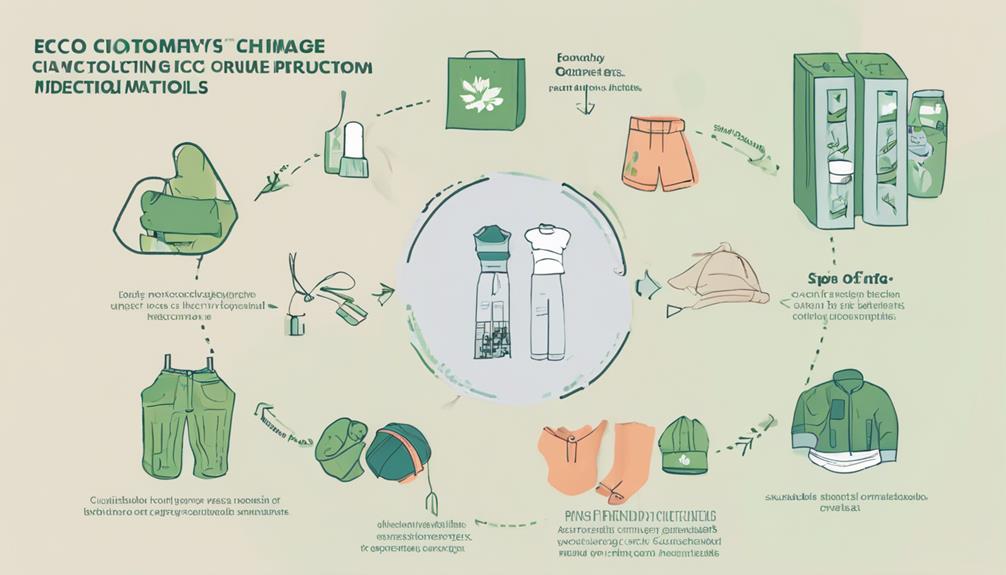How-to Guide: Eco-Friendly Clothing Production Methods
In a world where sustainability is becoming increasingly crucial, understanding how to produce eco-friendly clothing is paramount.
By implementing organic fabric selection, water conservation techniques, energy-efficient manufacturing processes, minimal waste production strategies, non-toxic dyeing methods, fair trade practices, circular economy principles, and maintaining a transparent and traceable supply chain, you can significantly reduce the environmental impact of your clothing production.
But, there's one key aspect that ties all these methods together, ensuring a holistic approach to sustainable fashion.
Organic Fabric Selection
When choosing organic fabrics for eco-friendly clothing production, consider the impact on both the environment and the quality of the final product. Sustainable sourcing is essential in ensuring that the materials used in your clothing line aren't only environmentally friendly but also ethically produced. Look for suppliers that prioritize fair trade practices and environmentally conscious manufacturing processes. By selecting fabrics from such sources, you contribute to a more sustainable fashion industry.
Opt for eco-friendly fibers like organic cotton, hemp, bamboo, and Tencel. These materials are grown and processed using methods that have minimal impact on the environment. Organic cotton, for example, is cultivated without the use of harmful pesticides and synthetic fertilizers, making it a healthier choice for both the planet and the consumer. Hemp is another excellent option as it requires minimal water and no pesticides to grow.
Bamboo is a fast-growing plant that's renewable and biodegradable, making it a popular choice for eco-conscious clothing brands. Tencel, a type of lyocell fabric made from sustainably sourced wood pulp, isn't only eco-friendly but also known for its softness and breathability.
Water Conservation Techniques
Consider implementing innovative water conservation techniques in your clothing production process to minimize water wastage and promote sustainability. To achieve this, you can utilize various methods such as rainwater harvesting, sustainable irrigation, greywater recycling, and water-saving technologies.
Rainwater harvesting involves collecting and storing rainwater for later use in production processes. By capturing rainwater, you can reduce your reliance on freshwater sources, decreasing the overall water consumption of your operations.
Implementing sustainable irrigation practices, like drip irrigation systems, can help deliver water directly to the roots of plants, maximizing efficiency and reducing water runoff.
Greywater recycling is another effective technique that involves treating wastewater from sinks, showers, and laundry facilities for reuse in non-potable functions such as irrigation or toilet flushing. This helps conserve freshwater resources and minimizes the amount of water that goes to waste.
Integrating water-saving technologies such as low-flow fixtures, water-efficient machinery, and monitoring systems can further enhance your water conservation efforts. These technologies optimize water usage throughout the production process, ensuring that every drop is utilized efficiently.
Energy-Efficient Manufacturing Processes
Implement energy-efficient manufacturing processes to reduce your carbon footprint and minimize environmental impact. By utilizing renewable resources and green technology, you can significantly decrease the energy consumption of your clothing production operations.
Here are three key ways to implement energy-efficient manufacturing processes:
- Utilize renewable resources: Switch to renewable energy sources such as solar or wind power to run your manufacturing facilities. By harnessing the power of nature, you can reduce your reliance on fossil fuels and lower your carbon emissions.
- Invest in energy-efficient equipment: Upgrade your machinery to more energy-efficient models that consume less power while maintaining high productivity levels. Look for certifications like Energy Star to ensure that your equipment meets stringent energy efficiency standards.
- Implement smart production practices: Optimize your production schedules to reduce energy waste and maximize efficiency. Utilize automation and advanced monitoring systems to track energy usage in real-time and make adjustments for optimal performance.
Minimal Waste Production Strategies
To minimize waste in clothing production, focus on efficient resource utilization and streamlined manufacturing processes. Zero waste designs are an innovative approach that aims to create patterns for garments that generate little to no fabric waste during production. By carefully planning pattern layouts and utilizing fabric pieces in a strategic manner, zero waste designs help reduce the amount of unused fabric that typically ends up as waste in traditional production methods.
Another effective strategy is the use of upcycling techniques, which involve transforming discarded or unused materials into new clothing items. This process not only reduces waste but also adds a unique and creative touch to the final products. Upcycling allows designers to repurpose materials like old clothing, fabric scraps, or vintage textiles, giving them a new life and purpose in the fashion industry.
Non-Toxic Dyeing Methods
Opt for eco-friendly dyeing methods to reduce environmental impact in clothing production. By choosing eco-conscious dyeing techniques and sustainable colorants, you can contribute to a cleaner and greener fashion industry. Here are some non-toxic dyeing methods to consider:
- Natural Dyes: Utilize plant-based dyes such as indigo, turmeric, or madder root. These dyes are biodegradable and don't contain harmful chemicals, making them a great eco-friendly alternative to synthetic dyes.
- Low-Impact Fiber-Reactive Dyes: Opt for fiber-reactive dyes that have a lower environmental impact compared to traditional dyes. These dyes form a strong bond with the fabric, resulting in long-lasting colors without the need for toxic fixatives.
- Waterless Dyeing Processes: Explore innovative waterless dyeing technologies that use methods like air dyeing or digital printing. These processes eliminate the need for large amounts of water typically used in traditional dyeing, reducing water pollution and conserving this precious resource.
Fair Trade Practices
Consider fostering ethical production by engaging in fair trade practices when manufacturing clothing items. Ethical sourcing is a crucial aspect of sustainable fashion production. By prioritizing ethical sourcing, you ensure that the materials used in your clothing items are obtained in a responsible and sustainable manner. This means choosing suppliers who adhere to fair labor practices, prioritize worker well-being, and minimize environmental impact.
Worker empowerment is another key element of fair trade practices in clothing production. Empowering workers involves providing them with fair wages, safe working conditions, and opportunities for growth and development. When workers are treated ethically and with respect, they're more motivated, leading to higher productivity and better quality products. By prioritizing worker empowerment, you contribute to creating a more equitable and sustainable fashion industry.
When implementing fair trade practices, it's essential to work closely with your suppliers to ensure that these standards are being met throughout the production process. Regular audits and transparent communication can help maintain accountability and foster a culture of ethical responsibility. By incorporating fair trade practices into your clothing production methods, you not only contribute to a more sustainable industry but also support the well-being of workers and communities around the world.
Circular Economy Principles

Prioritize the implementation of circular economy principles in your clothing production methods to enhance sustainability and reduce waste. By adopting sustainable sourcing practices and incorporating closed loop systems into your manufacturing process, you can significantly minimize your environmental impact and contribute to a more sustainable future for the fashion industry.
To effectively integrate circular economy principles into your clothing production methods, consider the following steps:
- Sustainable Sourcing: Ensure that your materials are ethically and responsibly sourced. Look for organic, recycled, or upcycled materials to reduce the environmental footprint of your garments. By choosing sustainable sourcing options, you can support eco-friendly practices from the beginning of your supply chain.
- Closed Loop Systems: Implement closed loop systems that allow materials to be recycled and reused in a continuous cycle. Design your products with the end in mind, making it easier to disassemble and recycle them at the end of their life cycle. By closing the loop, you can reduce waste and promote a more circular approach to production.
- Resource Efficiency: Optimize your production processes to minimize energy consumption, water usage, and waste generation. Embrace innovative technologies that allow for more efficient use of resources and reduce the environmental impact of your operations. By maximizing resource efficiency, you can lower your carbon footprint and create a more sustainable production model.
Transparent and Traceable Supply Chain
Ensuring transparency and traceability in your supply chain is crucial for maintaining ethical standards and accountability in your clothing production methods. Ethical sourcing involves selecting materials and manufacturing processes that prioritize fair labor practices, environmental sustainability, and animal welfare. By promoting ethical sourcing, you contribute to a more socially responsible and environmentally friendly industry.
To uphold ethical standards, it's vital to prioritize supply transparency. This means knowing where your materials come from, how they were produced, and under what conditions. Transparent supply chains allow you to verify that your suppliers adhere to ethical guidelines and avoid supporting practices that harm workers or the environment.
Implementing traceable sourcing practices enables you to track the journey of your materials from their origin to the final product. This visibility helps you identify any potential ethical concerns or environmental impacts along the way. By understanding your supply chain thoroughly, you can make informed decisions to mitigate risks and improve the sustainability of your clothing production.
Incorporating ethical sourcing and ensuring transparency in your supply chain not only aligns with eco-friendly principles but also demonstrates your commitment to responsible business practices. By prioritizing ethical standards and transparency, you contribute to a more sustainable and ethical fashion industry.
Frequently Asked Questions
Are There Any Specific Certifications or Labels Consumers Should Look for When Purchasing Eco-Friendly Clothing?
When buying eco-friendly clothing, keep an eye out for certification standards like GOTS or Oeko-Tex and sustainability labels such as Fair Trade or USDA Organic. These indicators ensure that the clothes have met specific environmental and ethical criteria.
How Can Consumers Ensure That the Eco-Friendly Clothing They Purchase Is Ethically Produced and Not Just Marketed as Such?
To ensure the eco-friendly clothing you buy is truly ethically produced, consumer awareness is key. Look for brands that prioritize transparency in their supply chain and emphasize ethical sourcing practices.
Research companies' commitment to fair labor standards, sustainable materials, and environmentally friendly production processes.
What Are Some Innovative Technologies Being Used in the Eco-Friendly Clothing Production Industry?
When looking into eco-friendly clothing production, you'll find sustainable textiles like organic cotton and Tencel being used.
Green technologies such as waterless dyeing methods and solar-powered factories are making waves in the industry. These innovations are revolutionizing the way clothes are made, reducing environmental impact and promoting sustainability.
How Do Eco-Friendly Clothing Production Methods Compare in Terms of Cost and Scalability to Traditional Methods?
When it comes to eco-friendly clothing production methods, cost comparison reveals that while initial expenses may be higher, long-term benefits often outweigh them.
Scalability analysis shows that as demand for sustainable fashion grows, these methods are becoming more viable and efficient.
Embracing eco-friendly practices not only supports the environment but also aligns with consumer preferences, providing a competitive edge in the market.
Are There Any Challenges or Limitations to Implementing Sustainable Practices in the Fashion Industry as a Whole?
Implementing sustainable practices in the fashion industry poses challenges like higher initial costs, lack of infrastructure, and resistance to change.
However, solutions to eco-friendly clothing production limitations can be found through innovation, technology advancements, and collaboration.
Conclusion
Now that you have learned about eco-friendly clothing production methods, you can make informed choices to support sustainable fashion.
By selecting organic fabrics, conserving water, using energy-efficient processes, minimizing waste, opting for non-toxic dyes, practicing fair trade, embracing circular economy principles, and ensuring transparency in the supply chain, you can contribute to a greener and cleaner fashion industry.
Make a difference with every purchase you make!
